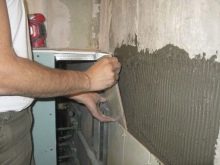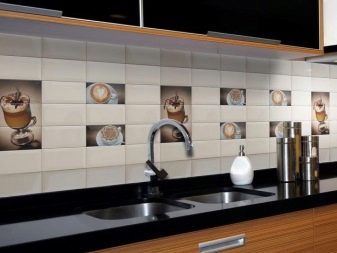Do-it-yourself apron: how to choose and lay out tiles for the kitchen?

In the arrangement of the kitchen, every little thing is important. The apron, which is located in the working area of this room, may seem to many to be an insignificant detail. In fact, a lot depends on it. A well-chosen and installed apron can decorate the interior, making it more attractive, harmonious and complete. Today we will analyze in detail how to decorate a working area in the kitchen with our own hands using tiles.



Tile recommendations
Tile is one of the most popular and common materials chosen for finishing an apron in the kitchen. This design is found in many interiors. It is quite possible to execute it on your own, without resorting to a team of experienced finishers. However, the tiles must be chosen correctly. In this case, some nuances should be taken into account.
- The apron, which takes place in the working area of the kitchen, must necessarily have a smooth and unpretentious surface, which can be easily cleaned of dirt and greasy stains. Glazed tiles meet this requirement.
- This finishing material must be chosen so that during installation work, a minimum area is separated at the seams. This is due to the fact that usually in such areas the most dirt accumulates, and it can be difficult to clean it there.
- The color of the backsplash tile is also important. It should overlap with the colors of the kitchen furniture.



There are several types of tiles that are suitable for decorating the work area in the kitchen. Let's get acquainted with them.
Ceramic
Such tiles are rectangular or square plates. They are made from a fired solution consisting of clay, quartz sand and minerals. These components provide the material with high strength and high temperature resistance. Ceramic tiles are made using different technologies: with one or two annealing. The basis of the material is high- and low-porosity. The front part of the tile can be glazed or plain.


Mosaic
This material consists of small ceramic pieces that are glued to the wall base. In most cases, such products are turned to if it is necessary to carefully arrange rounded surfaces. Mosaic tiles are sold in the form of rolls or square sheets. It is placed on a special tile adhesive. Fuges after drying. Currently, mosaic material is presented in a huge assortment. The stores sell options in a wide variety of colors and textures. It is possible to choose a glazed or matte version.
However, this material has a large number of seams - the most vulnerable areas where contamination often accumulates.


"Wild boar"
This name is given to ceramic rectangular tiles of standard sizes, which have beveled corners at 45 degrees or rounded edges. Initially, the "hog" was made exclusively for exterior finishing works, but with the development of technologies that improved the characteristics of this material, they began to use it for interior decoration. "Kabanchik" is distinguished by excellent strength characteristics, a wide assortment (there are both glazed and simple versions on sale), a large selection of colors. The standard installation of this material in the kitchen work area is carried out in a staggered manner, like brickwork.At the end of finishing work, all joints are closed with a fugue.
An analogue of the "hog" is a plaster decorative tile, painted in various shades. Basically, only private companies produce such materials. Gypsum absorbs moisture well and cannot boast of high strength characteristics, so this type of finish is extremely rarely used in kitchen design.


Clinker
This tile is made from various types of clay with dye and special additives. The clinker is characterized by high strength due to the high annealing temperature. Clinker is used for both interior and exterior decoration.

Photo tile
With the advent of modern photo printing technologies, it became possible to produce tiles with any patterns and images. Previously, they were applied only to special ceramic tiles, on which a special polymer composition is present. Today, the possibilities have expanded - images can now be applied to any material. With the help of well-chosen photo tiles, the owners have the opportunity to effectively and original decorate the kitchen workspace.
These materials are laid in the same way as the classic options, but they look much more interesting. Photo printing can be both on the entire surface of the tiles, and only in certain areas.


How to calculate?
If you plan to lay out an apron from a tile in the kitchen on your own, then first you need to correctly calculate the amount of material. You can carry out all the calculations using a convenient online calculator, or do everything yourself. To do this, it will be necessary to clarify the dimensions of the area (both length, width, and height parameters) on which finishing work will be carried out. In this case, you need to rely on the standard parameters.
- The work area is usually about 55-57 centimeters high from the line of the countertops. Of course, this parameter sometimes reaches the floor level - it all depends on how the pedestals are located.
- Ceramic tiles must necessarily go under the countertops by at least 20 mm so that water and dirt do not accumulate in the seams.
- In the upper part, the apron is installed before the hood itself - this equipment is usually mounted at a height of 65-75 centimeters from the stove.
- The horizontal work surface parameter is the entire length of the wall. It is possible to stop and only at the section "sink-working pedestal-plate".
Be sure to carry out all the necessary calculations. In order to calculate and do everything correctly, you will need to decide which way you will lay the tiles for the apron. The layout is very important here.


Masonry options
There are many options for laying backsplash tiles. It is worth highlighting the most popular varieties:
- standard (or basic);
- diagonal;
- under the brickwork.
It is the basic layout of the tile that is recognized as the simplest. If you choose it, then you can count on the fact that the overrun of material will be insignificant.



Step-by-step installation instructions
It is possible to lay out an apron from a tile with your own hands. The main thing is to lay the material correctly and do everything in accordance with the instructions. Let us consider in stages how the installation of such a finish is carried out.
First you need to prepare the wall foundations. This is done as follows.
- Thoroughly clean the wall from the old coating. If earlier there was a tile, then it will have to be cleaned using a perforator. It is necessary to clean the base up to the plaster layer. Do not leave a trace of the old finish, otherwise the fresh material will not adhere well to the surface or will lie unevenly.
- Make sure that the plaster layer of the wall is firmly seated. Particles that are subject to detachment will need to be removed from the base. After that, all uneven areas will need to be leveled.
- Try to make the most correct and even corner in the event that the coating will go from one wall to another.
- It is best to leave notches on the walls so that the adhesive composition better adheres to their base.


After preparing the wall, you can safely move on.
- Make a line according to the size of the apron. At this stage, accuracy and accuracy should be observed so that during further work you do not encounter a discrepancy between individual parts.
- Place an even block of wood on a horizontal level - it will play the role of supporting the material in the lower part, preventing it from rolling down.
- To prepare a vertical mark, fix the plumb line correctly - the lace with a weight will need to be set at the top of the wall, from where it will go down, forming a perfectly flat base for marking.
- Having correctly marked the base on which the finishing material will be laid, it will be necessary to properly prepare the adhesive composition. If you do this incorrectly, in violation of the manufacturer's instructions, then the adhesive layer will quickly become useless and the tile will simply fall, so you need to act in accordance with all the rules.
- Do not use solutions that begin to dry out during work. Their dissolution will be useless - the adhesive properties of such mixtures will still be irretrievably lost. The tiles will not last long on them.


- Now you can start to lay the apron. For an inexperienced home craftsman, it is best to lay out such a finish using an orderly styling method. Not the least role is played by the dimensional parameters of the tile - the larger it is, the easier it will be to work. There will also be fewer joints, so maintenance will be easier too. That is why experienced craftsmen do not advise beginners to undertake the installation of finishes, consisting of a large number of small parts.
- First you need to lay a layer of glue on the wall. Spread it evenly over the substrate using a spatula. As a result, the wall must be completely covered with a grooved adhesive.
- The tile must be glued, gently pressing it to the base with glue. After that, you will need to take a rubber mallet. Shrink the tiles with this fixture.
- If you started laying out the material from the edge, then at the same moment lay the corner. After that, check the horizontal and vertical of the installed part using a special small level (it will be inconvenient to work with a standard large tool in such areas).
- The rest of the tiles in this row should be laid using the same method.
- You should proceed to the installation of the next row only after the previous one dries out to the end. Remember that the starting row is the most important because, based on its location, all other rows will fit. Let the first styling line dry for 24 hours.



- At the final stage, you will need to trim individual elements and lay the remaining resulting pieces. The cut line must be drawn using a ruler on the back, and then use a tile cutter, a grinder or a glass cutter.
- As soon as the entire working area in the kitchen is fully laid out, and the tile is fully seized with the base, it can be gently tapped with a mallet. A dull sound when knocking will indicate that the tile does not fit very well. Such parts must be removed and reinstalled.
- When the quality of laying ceases to be in doubt, you can safely proceed to grouting. Before this, the finish will need to be washed from dust and dirt. The joints are rubbed with a rubber spatula. Then the joints are left to dry for 0.5-1 hour. Then the surfaces are leveled and processed with a rag.
Remember that the color of the grout should match the shade of the tiles you choose to finish. Fortunately, today in hardware stores, compositions of a wide variety of colors are sold, so choosing the right option is not difficult.


For information on how to make an apron from tiles for the kitchen with your own hands, see the next video.
Interesting examples
A kitchen apron made of tiles is a versatile and practical solution. Dirt, grease and soot are easier to wash off the tiles. Using a similar material, you can beautifully lay out the work area in any style: from classic to avant-garde. Colors can also be any, as well as their combinations.
Let's consider several interesting and harmonious options.
- Against the background of a minimalistic black and white kitchen set with metal fittings, an apron trimmed with mosaics will look gorgeous. In such a cladding with a predominance of white, gray, black, brown, beige colors can also be combined.

- Behind a cozy set made of natural chocolate-colored wood, you can lay out a discreet cream or yellowish-beige tile, in which a plain canvas is diluted with small images of autumn landscapes. With such a finish, the interior will look calm and welcoming.
- A contemporary-style set with sideboards with a distinct visual wood print and glossy black countertops, it goes well with a tiled backsplash. In the latter, laconic white tiles can be combined with images of coffee, cocktails and other drinks. Such a tandem should be diluted with chrome parts. The end result is a very stylish, modern and expensive ensemble.


- An apron made of snow-white glossy tiles for brickwork will look good in combination with a white or dairy set and appliances in a retro or Provence style. A small round teapot with a floral print, small waffle towels with similar patterns will complement such an interior. Thus, you get a delicate ensemble with elegant notes of antiquity and classics.














The comment was sent successfully.